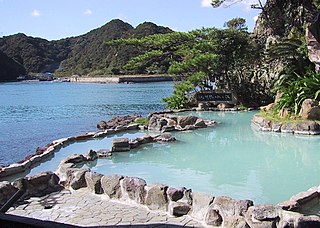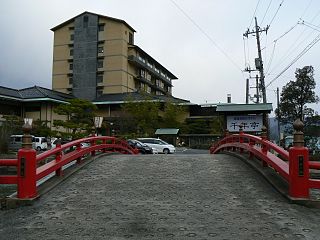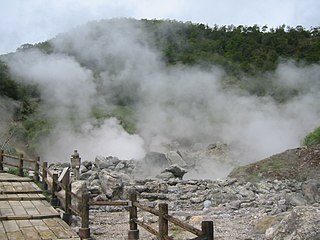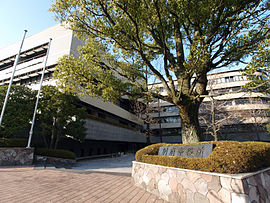
Ōita Prefecture is a prefecture of Japan located on the island of Kyūshū. Ōita Prefecture has a population of 1,136,245 and has a geographic area of 6,340 km2. Ōita Prefecture borders Fukuoka Prefecture to the northwest, Kumamoto Prefecture to the southwest, and Miyazaki Prefecture to the south.

In Japan, onsen are hot springs and the bathing facilities and traditional inns around them. There are approximately 25,000 hot spring sources throughout Japan, and approximately 3,000 onsen establishments use naturally hot water from these geothermally heated springs.

Sentō (銭湯) is a type of Japanese communal bathhouse where customers pay for entrance. Traditionally these bathhouses have been quite utilitarian, with a tall barrier separating the sexes within one large room, a minimum of lined-up faucets on both sides, and a single large bath for the already washed bathers to sit in among others. Since the second half of the 20th century, these communal bathhouses have been decreasing in numbers as more and more Japanese residences now have baths. Some Japanese find social importance in going to public baths, out of the theory that physical proximity/intimacy brings emotional intimacy, which is termed skinship in pseudo-English Japanese. Others go to a sentō because they live in a small housing facility without a private bath or to enjoy bathing in a spacious room and to relax in saunas or jet baths that often accompany new or renovated sentōs.

Yufuin was a town located in Ōita District, Ōita Prefecture, Japan. Yufuin is now a district within the city of Yufu. Its elevation is approximately 400 meters above ground.

Dōgo Onsen (道後温泉) is a hot spring in the city of Matsuyama, Ehime Prefecture on the island of Shikoku, Japan.

Nasu is a town located in Tochigi Prefecture, Japan. As of 1 August 2020, the town had an estimated population of 24,851 in 10,400 households, and a population density of 67 persons per km2. The total area of the town is 372.34 square kilometres (143.76 sq mi).

Aso-Kujū National Park is a national park in Kumamoto and Ōita Prefectures, Japan. The park derives its name from Mount Aso, the largest active volcano in Japan, and the Kujū mountains. Mount Aso is also one of the largest caldera volcanos in the world.

Ōita is the capital city of Ōita Prefecture, located on the island of Kyushu, Japan. As of 30 November 2023, the city had an estimated population of 474,804 in 230,867 households, and a population density of 950 persons per km2. The total area of the city is 502.38 km2 (193.97 sq mi).
Kankaiji onsen (観海寺温泉) is a natural hot spring located near Beppu, Japan. The waters of this hot spring are channels to several bathing resorts and is one of the most popular tourist destinations in its locale.

The Beppu Ropeway is a Japanese aerial lift line in Beppu, Ōita. This is the only line operated by Beppu Ropeway, a subsidiary of the Kintetsu Group. Opened in 1962, the line climbs Mount Tsurumi near the Beppu onsen hot spring resort. The mountain is most famous as one of the few hard rime sights in Kyūshū. The line operates the whole year.

Mount Yufu is a 1,583.3 m (5,195 ft) volcano located on the border of Yufu and Beppu, Ōita, Japan. It is located within Aso Kujū National Park.

Takanoyu Onsen (鷹の湯温泉) is one of several hot springs in the Akinomiya Hot Springs area of the city of Yuzawa, in southern Akita Prefecture. The onsen is nestled in a small gorge along the banks of the Yakunai River. Because of its secluded location, it is referred to as a Hitou, or hidden hot spring.

Beppu Daigaku Station is a passenger railway station located in the city of Beppu, Ōita Prefecture, Japan. It is operated by JR Kyushu.

Beppu Onsen (別府温泉) is an extensive hot spring system in the city of Beppu, Ōita, Japan. There are eight distinct major thermal spring zones called "Beppu Hatto"(別府八湯).

The hot spring system Hells of Beppu is a nationally designated "Place of Scenic Beauty" in the onsen town of Beppu, Ōita, Japan. The "hells," or "jigoku" (地獄) in Japanese, are for viewing rather than bathing.
Verspah Oita is a Japanese football club based in the city of Ōita, capital of Ōita Prefecture. They currently play in the Japan Football League, the fourth tier of Japanese league football. The 2023 season is their 12th consecutive season in the JFL.

Hawai Onsen (はわい温泉) is an onsen in the town of Yurihama, Tōhaku District, in Japan's Tottori Prefecture. In recent years, it is the fourth most popular onsen in the prefecture, following Kaike Onsen, Misasa Onsen, and Yoshioka Onsen. It forms part of Misasa-Tōgōko Prefectural Natural Park, and some of the onsen district's lakeside area sits within Lake Tōgō Hawai Seaside Park.

Unzen Onsen is a geothermally heated volcanic hot spring field in the Unzen Mountains in Nagasaki prefecture in Japan. It was known of for many years, and in the 1910s was developed into a hot spring community because of its many springs. In 1934 the area was designated as the first national park in Japan.

Hyotan Onsen (ひょうたん温泉) is a large onsen bathing facility located in Kannawa, Beppu, Ōita Prefecture. Opened in 1922, Hyotan Onsen is notable for being the only onsen facility in Japan to have received three Michelin Stars from Michelin Green Guides Japan.



























